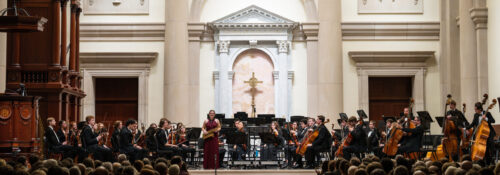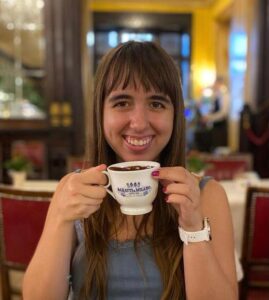
A Fitting Fanfare
Written by Erika Kyba
In late October 2023, Hillsdale’s Symphony Orchestra graced campus with its first performance of 2023. The concert began with a piece composed by the conductor, visiting professor Dr. Mark S. Douglass, called “Fanfare for Orchestra.” A tour de force celebration of parenthood, “Fanfare for Orchestra” was a perfect choice since the orchestra performed during Parents Weekend.
Dr. Douglass dedicated the piece to his two sons, creating musical motives within the fanfare for each of them. The middle of the song was crafted to convey a sense of the lullabies that their mother sang for them, her voice contained within the clarinet and flute melodies. This was followed by a triumphant finale that symbolized “the soaring dreams of a loving father,” and the hope that parents have to see their children succeed and become who they were meant to be.
Violist Emily Schutte, ’26, said the experience of working with Dr. Douglass was special because, as the composer, he knew exactly what he wanted the piece to sound like: “He could mold how we were playing in order to achieve that.”
Dr. Douglass said conducting the piece was “very, very nerve-wracking,” as the subject of the fanfare was “so transparent, and so personal.” He told me that some people view music as something that stands on its own, but that this is a misconception. Truly, it’s the opposite: while music is accessible to the listener, it will always reflect the intentions of its composer in the way that it is crafted.
The second piece performed was “Concertstück for Harp and Orchestra,” composed by Gabriel Pierné (1863-1937). It highlighted Magdalena Shaltanis, ’25, on the harp, playing a lovely, angelic melody. The third piece was “Concerto in E-flat Major for Alto Saxophone and String Orchestra,” by Alexander K. Glazunov (1865-1936). This piece highlighted Lydia Magyar, ’24, on the saxophone, an unusual instrumental choice for an orchestral piece. Dr. Douglass said the concertos were chosen through a competition. Magdalena and Lydia had chosen their own pieces to enter and were ultimately selected. Both students showed immense talent, performing without sheet music.
The last piece was “Symphony No. 9 in E Minor,” by Antonin Dvořák, a part of his larger New World Symphony. In four movements, the symphony captures the sense of adventure and wonder that immigrants encounter when first setting foot in the United States. “It’s a piece about Dvořák’s experience with America, and that resonates a lot with Hillsdale,” describes clarinetist Samuel Jarzab, ’26. “It’s beautifully written. It’s very interesting to see his interpretation of different places in America. It’s one of the great titans in the symphonic repertoire.”
The piece was popular with both the audience and with the musicians in the orchestra. Emily describes the piece as being her favorite one to play. “The way that Dvořák wrote the piece, it naturally builds different dynamics into it, and so I thought it was very intuitive. And it was so fun to play.”
Samuel told me about the images that come to mind when playing the piece. “The opening of the first movement represents the settlers coming to the new world. It’s very quiet, and it’s like the ship is coming to shore, and it’s in the fog. The second movement has the open sound of the prairies, for example. Or the third movement has the Western, folksy influence. The fourth movement is the triumphant sound of the American Dream.”
Flutist Elena Bull, ’26, agrees that the piece is meticulously structured. “In the fourth movement, a lot of the themes from the first three movements came back, and it tied the whole piece together. Also, he [Dvořák] used instrumentation to bring out different effects that he wanted in the music, mostly based on tone colors and different instruments and how solo lines overlap sometimes.”
Dr. Douglass described the piece as one that he and Professor James Holleman had selected together and studied extensively. He said it was “a growing piece for everybody” due to its dense musical texture, but also that the New World Symphony was more accessible to the audience’s ear, with full bar phrases.
Dr. Douglass has a storied musical career. As the program describes, “His performances have graced esteemed stages, from the Detroit Jazz Festival to the prestigious Bourbon Jazz Festival in Paraty, Brazil, and from the enchanting Meerscheinschlössl Hall in Austria to the iconic Carnegie Hall.” In addition to performing, he also composes, teaches, and runs the ConTempus Initiative, a music collective dedicated to bringing performances of new music to contemporary audiences.
Emily shared with me how much she enjoyed working with Dr. Douglass: “I loved working with him. He’s very kind and passionate about what he does. I loved seeing his passion for the music.”
Samuel described how much he learned from Dr. Douglass. “Working with Professor Douglass was fantastic,” Samuel said. “It was great to experience a different conducting style. The biggest thing I learned was micro-rehearsing, where you rehearse short sections and pull together the areas you’re struggling with. So for example, we’ll work on a short section, and then we’ll skip a bunch and work on a different section. Those are the zoomed-in micro-rehearsals. Then we’ll have macro-rehearsals where we play the entire thing. You learn how everything fits in.”
Hillsdale is special to Dr. Douglass. He appreciates the integrity of Hillsdale students: “When they say they’ll practice, they’ll practice.” Their talent and their dedication, Dr. Douglass told me, also play a major role in their success, as they “are truly desirous of excellence.” Dr. Douglass also credited the great instruction that the students had received from James Holleman and also Dr. Melissa Knecht, who teaches violin and viola.
 Erika Kyba, ’26, is a prospective English major from Saint Paul, MN. Outside of class, she enjoys reading the Classics, watching rom coms, writing fiction, and listening to 80s music.
Erika Kyba, ’26, is a prospective English major from Saint Paul, MN. Outside of class, she enjoys reading the Classics, watching rom coms, writing fiction, and listening to 80s music.
Published in December 2023